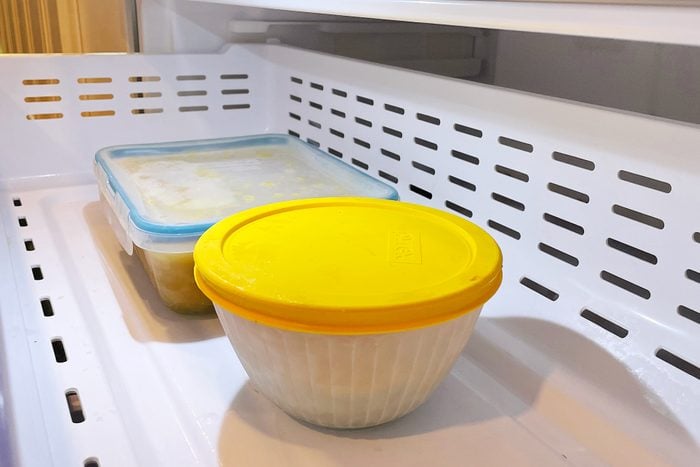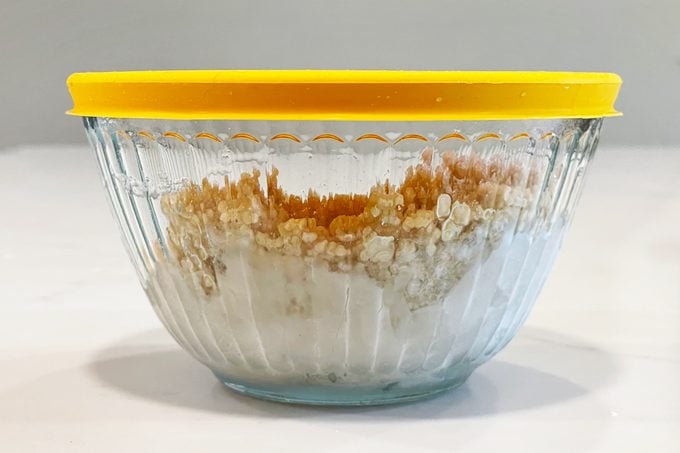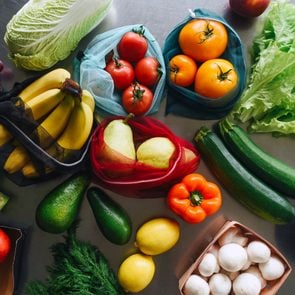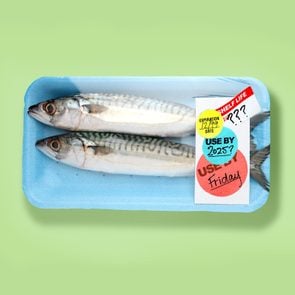Can You Put Glass in the Freezer?
Updated: Apr. 08, 2024

Storing food in glass containers is easy, sustainable and practical. Here's what you need to know about putting glass in the freezer.
Whether you’re trying to save time during the week by stockpiling premade meals, reduce food waste by storing leftovers or save money by extending the shelf life of food, the freezer is an incredible tool. To optimize the appliance, start by organizing the freezer (working on your fridge organization and kitchen organization wouldn’t hurt either). Next comes determining the best food storage containers: Are freezer bags the best way to go? Can you put glass in the freezer? Or should you mummify your food in plastic wrap?
Glass storage containers, it turns out, are an excellent choice, whether you’re organizing a chest freezer, side-by-side machine or freezer drawer. “Glass is great because it is odor and stain resistant; it’s oven, dishwasher and microwave safe; and it does a great job of protecting food,” says chef Ashley Christensen, who co-authored It’s Always Freezer Season with Kaitlyn Goalen. Glass also comes with fewer safety concerns than plastic containers. “Although almost all plastic food storage containers are now made without BPA [the compound that was at the center of the public-health debate], some people still have lingering concerns over the safety of plastic in the long term,” she says.
Keep reading to learn the instances in which you can put glass in the freezer and get expert-backed tips for freezing food.
Can you put glass in the freezer?
Yes, you can! Not only can you put glass in the freezer, but glass containers are a great sustainable pick. Unlike plastic, glass is not porous, so the containers will neither stain nor hold smells. They are sturdy and durable, which makes it easy to stack containers on top of one another to fit as many in your freezer as you can (no need for a professional organizer!). Unlike a zip-top freezer bag, glass containers can go in the microwave or the oven and into the dishwasher afterward, which makes reheating a freezer meal a breeze.
Can glass crack in the freezer?
If you don’t choose the correct glass containers or you try to speed through the freezing and thawing processes, the glass can crack. You have thermal shock to thank for that. It’s what happens when the temperature of a substance changes too quickly, and it can result in cracking or even shattering. Glass is particularly vulnerable to thermal shock—it’s why glass windows often break or blow out when there is a fire inside of a building.
Glass containers can also crack if they are too full of liquid when they go into the freezer. There are steps you can take to prevent thermal shock and cracks from expansion, which you’ll find below.
But can you put glass in the freezer no matter the type? That’s a no. If your glass containers are not durable enough for the freezer, they may not be able to withstand the low temperature that a freezer should be. Never put a glass container in the freezer if it’s not specifically labeled freezer safe—you may wind up with a mess on your hands.
Glass-storage tips

Ready to store some leftovers in the freezer? The tips below will help you use glass containers in the freezer without any issues.
Cool food before freezing
Filling a glass container with hot food and putting it straight into the freezer puts your container at risk for thermal shock. On top of that, freezing food that hasn’t completely cooled increases the risk for bacteria growth—the outside can freeze first, keeping the inside warm for long enough that harmful bacteria have a chance to grow. That could lead to foodborne illness. To avoid both of these possibilities, cool your cooked food to room temperature and then chill it in the fridge before transferring it to the freezer.
Of course, this doesn’t apply to foods that are already cold, such as meat, butter and produce. There are steps you’ll want to take when it comes to freezing these foods, but cooling won’t be an issue.
Choose silicone-lined lids
“Choosing the container is only half the equation. Just as important is choosing the lid or cover,” says Christensen. Lids lined with silicone ensure an airtight seal, which makes them ideal for freezing food—to maintain freshness and avoid freezer burn, you want to limit air exposure as much as possible. Latches on the lid help with this as well. Christensen uses Rubbermaid glass food storage containers, which boast both of these characteristics, as do these GlassLock Assorted Containers.
But wait, can you freeze glass jars? The answer is yes. And Mason jars would be the exception to the silicone-lined and latched rule, thanks to the lid and band design. Make sure the flat lid is concave before you screw on the band; it’ll ensure the jar is airtight. According to the pros at Mason Jars, you should freeze only wide-mouth, straight-sided jars (not those with the curved shoulder at the top) and leave about an inch of space at the top. Doing so will help you avoid the risks that come with expansion (more on that below).
Leave space for expansion
Packing food as snugly and as airtight as possible will help it stay fresh longer. But with glass, it’s not always best to fill the container all the way to the rim. That’s because liquid expands in the freezer—in fact, by the time it has frozen, it will have expanded by approximately 9%. So if you’re freezing broth, soup or stew, make sure to leave some room at the top of your container for this expansion. Otherwise, there’s a risk that the glass will crack. As long as you do, you can put glass in the freezer filled with all your favorite cold-weather delights.
Thaw before baking
One of the great things about glass storage containers is that they can safely go in the oven. If you freeze a casserole or lasagna in a glass baking dish, you won’t need to transfer it to another pan before reheating it. That said, it’s crucial to store the food in the refrigerator or at room temperature to thaw it before you put it in the oven. Taking this step will help you avoid thermal shock—yes, the same thermal shock that can happen during the freezing process.
One important distinction: You can cook frozen food without thawing it first by removing it from the freezer and placing it in an oven-safe dish. It’s really the glass container that you don’t want to put straight into the oven.
Don’t tie up your favorites
“Before you decide on how to package your food, keep in mind that you may be storing the dish in question for months,” notes Christensen. “Don’t accidentally take all of your best pans and containers out of kitchen rotation by using them for freezer storage.” Indeed, while it’s a cinch to bake something in a freezer-safe Pyrex glass baking dish, cool it, snap on the cover and slide it into the freezer, remember that you won’t be able to access it until you choose to eat that cake or pasta. “Either commit to purchasing a handful of vessels for freezer-only use or rely on disposable packaging,” she suggests.
By now, you should be able to answer “Can you put glass in the freezer?” It’s time to learn how long leftovers last in the fridge and how to store fresh herbs.
Get Reader’s Digest’s Read Up newsletter for more food, holidays, humor, cleaning, travel, tech and fun facts all week long.
Sources:
- Ashley Christensen, chef and co-author of It’s Always Freezer Season
- Science Direct: “Thermal Shock”
- Mason Jars: “Can You Freeze Mason Jars? At-a-Glance Tips for Freezing Your Food”
- The International Association for the Properties of Water and Steam: “Why does water expand when it freezes?”



